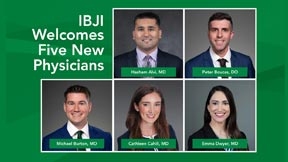Halloween is the perfect time to get creative with your family and friends, more specifically during pumpkin carving. Accidents while pumpkin carving can result in serious hand injuries causing nerve damage to the tendons and bones. IBJI’s Craig Phillips, MD, orthopedic surgeon with fellowship training in hand and upper extremity surgery, provides insight into safety while carving.
All it takes is a quick slip for an injury to occur. It is necessary to be cautious and attentive while carving pumpkins. You might find the following safety tips helpful.

Dr. Phillips’ tips for safe carving this Halloween:
- Do not cut towards your body.
- Make sure the pumpkin is dry before cutting to eliminate increased slip.
- Do not only use the tip of the knife when cutting a hole in the top of the pumpkin.
- Use a toothpick to poke out the triangles from the eye holes or a blunt end to push it out from the inside.
- Use a small serrated saw that comes in a pumpkin carving kit as they are less likely to become stuck in the pumpkin.
- Carve in a dry, clean, calm, and well-lit area.
- Set time aside so you do not rush.
- Always provide adult supervision for children.
- Let adults handle all knife carving.
- Children can help draw patterns, scoop out the insides and decorate the pumpkin once it has been carved.
What to do when a carving injury occurs?
In the event of a pumpkin carving accident, it is best to visit your local immediate care facilities like IBJI’s OrthoAccess. While some injuries are minor and do not require an extensive treatment plan, other injuries may involve nerves and tendons in the fingers that require additional follow-up with an orthopedic hand specialist. In such cases, a hand specialist will assess the injury and check if a tendon, blood vessel, nerves or combination of the three, have been damaged and will determine if surgery is required to repair the structure.
Be sure to follow the tips above to have a safe, accident-free pumpkin carving experience with your family and friends this season!
Craig Phillips, MD, is a board-certified orthopedic surgeon with a subspecialty certification in hand and upper extremity surgery, who specializes in treating the hand, wrist, elbow and shoulder. His practice focuses on all conditions affecting the arms with common conditions such as hand and wrist fractures, wrist arthritis, nerve problems such as carpal tunnel syndrome, rotator cuff tears, shoulder arthritis and shoulder replacements.
*This content is for information only and is not intended to replace the diagnosis, treatment, or medical advice from your treating healthcare professionals. The content does not provide medical advice, does not constitute the practice of medicine or other healthcare professional services, and does not create a doctor-patient relationship. You should not rely on this information as a substitute, nor does it replace professional medical advice, diagnosis, or treatment. If you have concerns or questions, seek the advice of your healthcare professionals. If you think you may have a medical emergency, call your doctor or 911 immediately. Do not rely on electronic communications or communicate through this website for immediate, urgent medical needs. This website is not designed to facilitate medical emergencies. The use of the information is at the reader’s own risk. The links are provided for information and convenience only. We cannot accept responsibility for the sites linked or the information found here. A link does not imply an endorsement of a site.




